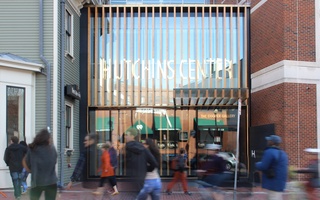{shortcode-60694b0a225edc64b907f3533cbc8a254c77d55d}
Dressed in mostly black cocktail attire and flashing camera-ready smiles, more than 500 students gathered on Nov. 6 to celebrate the opening of the Harvard Art Museums, newly renovated after six years of construction. Multi-colored flutes of nonalcoholic punch coupled with the pulsing beats of two DJs promoted a swanky, trendy vibe primed for the students to mix and mingle amid the art.
The opening signaled administrators’ hopes to make the Museums accessible and attractive to Harvard’s youngest affiliates.
University President Drew G. Faust has said the Museums are designed to serve as a “teaching machine,” as undergraduates, graduate students, and their professors collaborate and imagine new ways to use the Museums’ collection of over 250,000 pieces. Thomas W. Lentz, the director of the Museums, similarly called them “more open” and “accessible” at the Museums’ press opening earlier this month.
Now that the Museums have officially opened to the public, administrators want all students to take advantage of the collections. Certain classes will incorporate the gallery spaces and other facilities into their curricula, and others will direct enrollees to make use of the Museums’ collections on their own.
Some students, too, already have been at work behind the scenes of this Quincy Street institution. By designing public tours of the facilities, these students have become involved in the day-to-day life of the Fogg, Busch-Reisinger, and Arthur M. Sackler Museums—now all grouped under one “Harvard Art Museums” moniker. Administrators hope the renovation will push Harvard students to interact with art in a new, educational way.
“It’s not just for showing a beautiful collection of art,” architect Renzo Piano said of the Museums at a press opening. “It’s for studying.”
INTERACTIVE CLASSROOMS
Administrators at the newly renovated Harvard Art Museums, and the professors who plan to integrate various collections into their syllabi, say that they hope the facilities will fundamentally change how undergraduates interact with and think about art in their courses.
In total, four specific galleries in the Museums are dedicated to undergraduate coursework. Those galleries play a huge role in how the Museums function as classrooms, said Jessica L. Martinez ’95, the Museums’ director of academic and public programs.
These spaces will act as a “springboard” for further student inquiry and research, chief curator Deborah M. Kao said at the Museums’ press opening.
One of these spaces, the University Study Gallery, features one large display case that will showcase works selected by faculty members who want to incorporate the works into their course curricula.
“Faculty can select works from our storage—they can be installed for a day, a week, a month, the semester—to support their classes,” Martinez said.
Museums administrators hope that students across disciplines will benefit from the collections through their General Education courses, whose faculty instructors will have priority in installing exhibitions in the University Study Gallery.
“We really love that Gen Ed wants to bring the [aesthetic] disciplines into students’ lives, and we want to bring collections into students’ lives,” Martinez said. “When you go in, there is this wonderful juxtaposition of works that you wouldn’t typically see in other galleries, because it is the selection of professors from this range of classes.”
Read more in News
Panel Focuses on Rise in Boston's Urban AgricultureRecommended Articles
-
Community BRIEFSBus Breaks Down Returning From U.C. Sponsored Ski Trip A bus carrying 49 students returning from yesterday's Undergraduate Council-sponsored ski
-
Students Rarely Frequent MuseumsIn a glossy brochure given to all members of the Class of 1998, President Neil L. Rudenstine puts in a
-
ART MUSEUMS HOLD MEETING AT FOGGFifteen art museums throughout the country, including Boston's famous Gardner Museum, and Museum, of Fine Arts, and the Metropolitan Museum
-
 At Crossroads: The Ethelbert Cooper Gallery
At Crossroads: The Ethelbert Cooper Gallery -
 Gathering the Galleries
Gathering the Galleries













